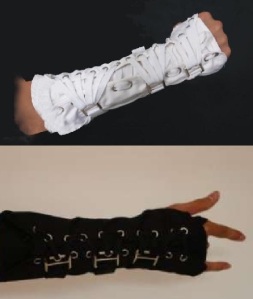Viola! Healing is no longer without options.
For years there was no choice…if you needed a bandage it was white and keeping it white was no easy feet. Cool Jaw introduces the T-800C TMJ/Facial Wrap with Chin Cup – now available in Black!
CoolJaw® jaw wraps are ideal for immediate use following wisdom tooth removal, reconstructive jaw surgery and dental implants. They are also great for use with TMJ and any other oral and maxillofacial jaw surgeries that require jaw compression and cold therapy.
Remember Michael Jackson’s Black or White Bandage statement? Apparently while shooting Black Or White one of the crew members had hurt their arm and Michael said can I borrow your arm bandage….Viola! It’s black or white fashion.
Cool Jaw’s Black face wrap may not top Michael’s “Black and White” Statement but it sure beats the following:
Cleaning a fresh blood stain is always preferable to a dried one. Usually, a quick rinse or soak with cold water will do the trick before the stain sets in. But many times, blood will set long before you even know there is a stain.
So on the occasions where you’re dealing with a set-in stain, here are a few tried and true methods to removing dry blood stains.
White Vinegar:
Vinegar has amazing cleaning powers, and is an incredibly inexpensive way of dealing with many household messes. Vinegar tops the charts for curing dried blood stains because it’s been proven to get out the worst stains, like those that have already gone through the dryer!
- If the stain is small, pour some vinegar in a bowl and submerge the stained area for about 30 minutes, then take a peek and see what is remaining and if it needs more time to soak.
- If the blood stain is larger, lay a towel under the stained area then soak with white vinegar and let sit for 30 minutes. Repeat if necessary until the stain is removed.
- Wash as usual but don’t put in the dryer until you are positive the stain is gone.
Hydrogen Peroxide:
Another tried and true product for cleaning dried blood stains is hydrogen peroxide. Simply pour the hydrogen peroxide directly onto the stain and let sit for a about 5 to 10 minutes, then blot it with a clean sponge or rag. Although it works great on whites, for colors, make sure you start with a drop in an inconspicuous part of the clothing first to make sure that it won’t ruin the color.
Hydrogen peroxide will turn to water when exposed to light so wrap the area with plastic wrap (so it won’t be absorbed) then cover with a towel.
Ammonia:
Ammonia will take dried blood out of anything as quick as a flash. However, it might take everything else with it. Again, with whites, ammonia is an easy solution, but you may want to use another method for any colors. But if all the other methods have failed, try ammonia. A big blood stain that won’t come out of something will be as ruined as one that’s been cleaned with ammonia, so you might as well try it as a last resort.
Tips for Treating a Dry Blood Stain:
- As a first option, soak in cold water overnight then move on to other options.
- Before treating, don’t leave a clean section of clothing under the stain. Move it out from under the stain or when you treat the stain it could transfer to a clean area of clothing.
If you’re not sure how a stain remover will react with your clothing, test in an inconspicuous spot first for colorfastness.*
*housecleaningcentral.com



